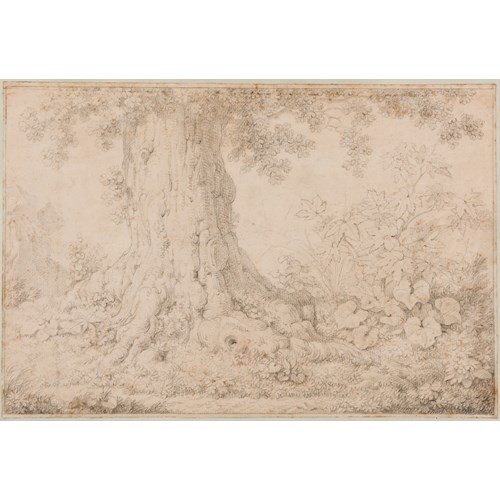Hendrick GOLTZIUS
Pluto, after Polidoro da Caravaggio
Date 1994
Period 20th century
Origin The Netherlands
Medium Pen, Brown ink, Brown wash, Heightened with white, Underdrawing in black chalk, On blue paper
Dimension 26.4 x 17 cm (10³/₈ x 6³/₄ inches)
While in Rome, Goltzius was particularly taken with the paintings of the 16th century Italian artist Polidoro da Caravaggio (c.1500-1543), who had developed a particular specialty as a painter of grisaillefrescoes for palace facades, often working in collaboration with a little-known Florentine painter by the name of Maturino. As James Byam Shaw has noted, ‘These façade-paintings, which Vasari always refers to as their joint work, were much admired and copied, especially by foreign artists visiting Rome. Those executed in chiaroscuro monochrome were considered particularly admirable; and their subjects, from ancient history or mythology, chiefly derived from Plutarch, Livy or Ovid, not only flattered the pride of the Romans themselves, but also provided a rich mine of iconography for visiting artists to take home with them. Hardly a trace of these famous paintings now remains on the walls of the Roman palaces.’
Polidoro da Caravaggio’s painted facades were seen throughout Rome, and Goltzius made drawn copies of several of them. The present sheet copies the figure of Pluto, one of a group of now-lost monochrome frescoes by Polidoro of eight Olympian gods in niches that adorned the façade of a house on the Quirinal Hill (also known as Monte Cavallo), near the church of San Silvestro al Quirinale. Although no longer extant, the appearance of the frescoes, which were likely executed after 1524, is recorded in a series of prints published many years later; by Cherubino Alberti in 1590, by Goltzius in 1592, and by Antonio Carenzano and Raffaello Guidi in 16135, as well as a number of drawn copies.
Goltzius made finished pen and wash drawings of each of the eight gods depicted on Polidoro’s façade. Six of these drawings – depicting Saturn, Neptune, Pluto, Vulcan, Jupiterand Mercury- are today in the Teylers Museum in Haarlem. The drawing for Apollois in the Kupferstichkabinett in Berlin, while the last drawing in the series, of Bacchus, has been lost since the 18th century. Among the Haarlem drawings is a slightly larger study of Pluto, the god of the underworld who holds a flaming torch to light his way, with which the present sheet can be closely related. After his return to Haarlem from Italy, Goltzius made engravings of his eight drawings after Polidoro’s Monte Cavallo façade frescoes, adding the name of each god at the bottom. The first print in the series, of Saturn, is dated 1592 and bears a Latin text which translates as: ‘[These] eight heathen gods were painted by Polidoro on a courtyard wall in the quarter of St. Paul’s Convent, on the Quirinal in Rome, now called Monte Cavallo. They are distinguished by the excellence of their clair-obscure effect. HG[oltzius] has sketched them on location and now engraved them for the use of students.’
The Goltzius scholar Emil Reznicek has suggested that the artist first made chalk or pen copies of the Polidoro frescoes in situ, before making more detailed studies in the studio, to serve in turn as models for the engravings. The present drawing of Pluto, which differs slightly from the Haarlem drawing and the related print in some details of the figure, and also does not include the winged figures and the decorative framing elements at the top of the niche, would appear to represent just such an earlier stage in the process of preparing the engravings. As Reznicek has pointed out, ‘Differences such as the figure’s placement in the niche and the more sketchy character of [the present] sheet suggest that it is preparatory for the drawing in Haarlem.’ Goltzius’s engraving of Pluto is, however, the only print in the series for which more than one preparatory drawing is known.
Date: 1994
Period: 20th century
Origin: The Netherlands
Medium: Pen, Brown ink, Brown wash, Heightened with white, Underdrawing in black chalk, On blue paper
Signature: Indistinctly inscribed a[?] H. Goltzius/ [?] / E. Reznicek 1994 in pencil on the backing sheet.
Dimension: 26.4 x 17 cm (10³/₈ x 6³/₄ inches)
Provenance: Emile E. Wolf, New York, by 1979
Given by him to Lisa Walborksy, New York, in 1984
Anonymous sale, Amsterdam, Sotheby’s, 8 November 2000, lot 35
By descent in the family of Emile Wolf.
Literature: Creighton E. Gilbert et al, Dutch Drawings of the Seventeenth Century from a Collection, exhibition catalogue, Ithaca, 1979, unpaginated, no.5; E. K. J. Reznicek, ‘Hendrik Goltzius 1558-1617: the complete engravings and woodcuts’ [book review], Simiolus: Netherlands Quarterly for the History of Art, 1978-1979, p.203, under Strauss 291; Walter L. Strauss, ed., The Illustrated Bartsch. 3 (Commentary). Netherlandish Artists: Hendrick Goltzius, New York, 1982, p.285, under no.0301.251; E. K. J. Reznicek, ‘Drawings by Hendrick Goltzius, Thirty Years Later: Supplement to the 1961 catalogue raisonné’, Master Drawings, Autumn 1993, p.250, no.K241a;Holm Bevers, ‘Unpublished Drawings by Hendrick Goltzius in Berlin’, Master Drawings, Winter 1997, p.394, under no.3;Marjolein Leesberg and Huigen Leeflang, The New Hollstein: Dutch & Flemish Etchings, Engravings and Woodcuts 1450-1700. Hendrick Goltzius, Part 2, Ouderkerk aan der IJssel, 2012, p.256, under No.(317) (as ‘likely to be a copy’); Yvonne Bleyerveld and Ilja M. Veldman, The Netherlandish Drawings of the 16th Century in Teylers Museum, Haarlem, 2016, p.146.
Exhibition: Ithaca, NY, Herbert F. Johnson Museum of Art, Cornell University, Dutch Drawings of the Seventeenth Century from a Collection, 1979, no.5.
More artworks from the Gallery









_T638722088181025454.jpg?width=500&height=500&mode=pad&scale=both&qlt=90&format=jpg)